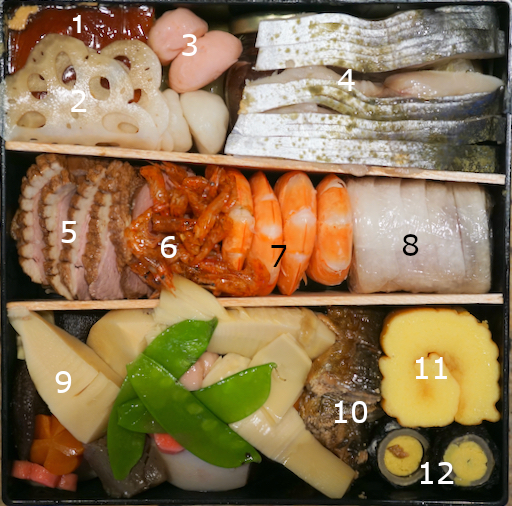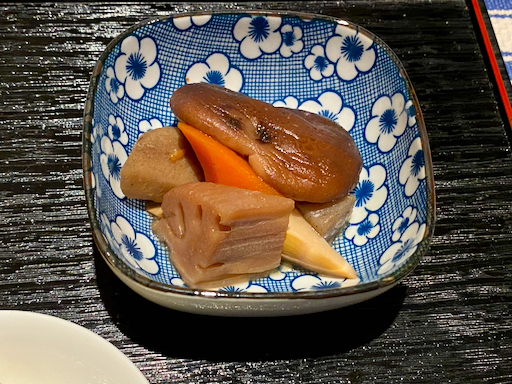Wednesday, November 15, 2023
Simmered “Shirataki” Konjac Noodle and Deep-fried Tofu しらたきと油揚の煮物
Ingredients:
1/3 package (about 100 grams) of “shirataki”, washed, boiled, washed again and cut into convenient length
1 small carrot, peeled and julienned
1 abura-age, hot water poured over (to thaw and remove excess oil), water squeezed out and then cut into thin threads
1 scallion finely chopped
300 ml Japanese dashi broth
30 ml sake
15 ml mirin
20 ml soy sauce (I used x4 concentrated Japanese noodle sauce)
Directions:
Add, the shirataki, carrot, and abura-age in a pot add the broth and cook for 5-10 minutes.
Add the seasonings and cook until the liquid is reduced by 1/3.
The original recipe calls for sugar but I did not add it. Japanese noodle sauce does have some sweetness which compensated for not having any sugar. This could be a side dish for rice but it is also perfect for a drinking snack.
Monday, January 8, 2018
New Year's day 2
One very good thing about this approach is that I can prepared the box ahead of time and keep it in the refrigerator and just grab it when we are ready.
Most of the ingredients came from the Sushi-taro osechi box. #1=sweet simmered "Kuromame" black beans 黒豆, #2="Matsukaze" chicken patty 松風焼き (which I made), #3="Konnyaku" simmered with Japanese "ichimi" red pepper 蒟蒻一味煮 (has mild zing), #4="Kuwai" arrowhead fried and simmered くわいの揚げ煮 and Simmered Shiitake mushroom 椎茸の旨煮, #5=Plum flower cut simmered carrot 梅人参, #6=Poached chicken tender with salted plum sauce 茹でささ身の梅肉和え(which I made, leftover from making New Year's soup), #7=Miso marinated egg yolk with walnuts 黄身胡桃 (this is also one of our favorite delicacies), #8=Salmon kelp roll 鮭の昆布巻 (which I made), #9=Kelp rolled and cured flounder with "gari"vinegared ginger 平目龍皮巻, #10=Date-maki omelet roll 伊達巻 (Osechi box also had this but this one is what I made), #11= Rib roast with Japanese mustard (leftover from Christmas roast), #12= Miso-marinated herring roe 数の子味噌漬, #13=Pork belly シルク豚味噌漬, and #14=Daikon namasu with "ikura" salmon roe and boiled octopus 大根なますイクラ煮だこ添 (Osechi box did include a more elaborate version of daikon namasu but I served what I made here).
This box contained chicken, beef, pork. I could have added duck since duck "terini" 鴨の照煮 was included in the large osechi box (see below).
This year, I could not get boiled octopus legs and had to be satisfied with the body/head of octopus.
Close up of flounder wrapped and cured in kelp with the center of "gari" ginger. Very refreshing.
"Kimi-kurumi" 黄身胡桃. I think this is egg yolk marinated in miso. Judging from the recipes I found, it would appear that after a few days, the egg yolks attain a very thick unique consistency. In this rendition, walnuts are embedded in the center. We love this dish, although I will not even try to make this myself.
After enjoying these delicacies, we went for the second plates. The big prawns were sake steamed and "bent back" symbolizes long life since old folks in old days all had bent backs or "Koshi-ga-magaru". This dish, in Japanese, was dubbed "longevity prawns" or 長寿海老. We removed the head and, of course, sucked on it and enjoyed the tail. In the center is duck "terini". I suppose this may be similar to what I make. I served this slightly heated.
The fish is sweet miso marinated Spanish mackerel 鰆西京焼. I heated it in the toaster oven for few minutes. I also added my gorgonzola dried fig chicken patty.
We ate something else for ending dish but do not remember. Having all these prepared osechi dishes is wonderful.
Monday, January 4, 2021
Sushi Taro Osechi 2021 寿司太郎の御節 2021
Everything was carefully prepared and packed. All possible superlative adjectives can not begin to describe how wonderful each dish was. I do not know how many orders they prepare but I got some glimpse of how much work this is from Chef Kitayama's instagram "chefmasayakitayama" and "togimax". Our only task now is to enjoy all these delicacies, something we are very good at.
Sunday, March 27, 2011
Sukiyaki すき焼き
Sukiyaki also reminds me of the very first time my wife and I visited Kyoto together so many years ago. Although we had visited Japan frequently we usually headed straight to Hokkaido occasionally staying only a few days in Tokyo. So the Japan my wife knew consisted of only Tokyo, Sapporo and other parts of Hokkaido. For her, Kyoto was an eye-opening experience--until then she thought all of Japan was like Hokkaido and was surprised to see how different it was.
Cooking: We did not cook the sukiyaki at the table this time. I placed a sukiyaki pot on the stove on medium low heat. I first melted a bit of butter (or you could use a chunk of beef fat) and spread the beef over the butter. The proper and traditional way of serving sukiyaki, is to season the meat after it has browned with sake, sugar and soy sauce. Then all the diners taste a small portion of this first cooked meat, since this is the only time browned meat was available to taste. (The rest of the beef added later is just cooked in the seasoning liquid). I do not see much advantage in this custom and I cooked everything together as you see on the right in the picture above. The vegetable and tofu exude water but if the liquid is not enough or the seasoning is too strong you could add more sake or dashi. I put on the lid and cooked it for 5 minutes or until the onion was done.
Sunday, January 14, 2018
New Year 3rd day evening 正月3日夕
All are from the Sushi taro osechi box. From left to right are daikon in yuzu sweet vinegar or "Nishiki namasu" 錦なます which was toped with soy sauce marinated salmon roe 青竹いくら. The center is steamed uni 蒸し雲丹, the right is a rare totally Western-style dish, oil marinated smoked oyster with feta cheese, dried tomato and olive 牡蠣燻製オイル漬け. All the dishes were heavenly. The yuzu flavor was very nice. What's not to like about uni in any form? The oysters were smoked, fat and succulent. We really liked this these dishes. They were good for sake or red wine.
This was followed by a tasting of herring roe or "Kazunoko" 数の子 prepared in three different ways. The top and bottom was what I prepared; the top is marinated in sake lee and miso and the bottom is marinated in dashi broth mirin and soy sauce. The center is from the osechi box; marinated in miso 数の子味噌ずけ (probably sweet miso like saikyo miso.
In the picture below, on the left is my sake lee miso marinated, the middle is my soy sauce marinated and the right is Sushitaro's miso marinated.
All three were very good and very distinctly different. It was a treat to be able to taste them all together like this. The center one appears a bit darker because I used regular or "koikuchi" soy sauce for the marinade instead of light colored "usukuchi" soy sauce. Although it looked different it tasted ok. (center).
This was followed by assorted dishes from the osechi box. I put the simmered vegetables in a separate bowl and microwaved briefly to take the chill off but didn't really warm them.
The plates included two grilled fish, Spanish mackerel marinated in saikyo miso and Japanese snapper with "kino-me" sauce. Both were heated in the toaster oven. Others included simmered sweet fish with it's roe, pickled myouga, flower cut pickled lotus root, date-maki omelet roll and burdock root dressed in sesame sauce or "Tataki gobo" たたき牛蒡.
Veggies included simmered Taro root or satoimo, kuwai, flower cut carrot, konnyaku and shiitake mushroom and snow pea.
Now we were in the last stretch of finishing the box. Even for us, this has been a rather wonderful decadent 3 days of New Year.
Sunday, January 30, 2022
Octopus rice 瀬戸内海蛸めし
We have been getting Japanese rice from the New York Rice factory. It may be hard to believe (we our selves are somewhat incredulous) that there could be such a difference in something as subtly flavored as rice but the rice from the rice factory is really good. It is hard to identify what sets it apart from the rice we used to get but in general we really like the texture, the taste and especially how well it can be reheated and still tastes like it just came out of the rice cooker.
Whenever I order rice from the rice factory I usually supplement the order with other items. In the past, we got a kit to make “red snapper rice” or “taimeshi” 鯛めし, a type of seasoned rice famous in the Japanese inland sea area or "seto-naikai" 瀬戸内海. Another time I ordered a similar seasoned rice kit made with octopus called “seto-naikai tako-meshi” 瀬戸内海蛸めし. After I bought it, however, the kit sat in our pantry for some time. When I checked the expiration date, it had expired the previous month, so I decide it was time to make it as a shime 〆 or ending dish one weekend. The kit came in several pouches; one with seasoning sauce, one with small bits of octopus, one with freeze dried items. It also included a rectangle of kelp. I made the octopus rice according to the instructions. I served it with a side of simmered Japanese root vegetables I had made and salted cucumber, daikon and nappa cabbage or "oshinko" お新香.




























